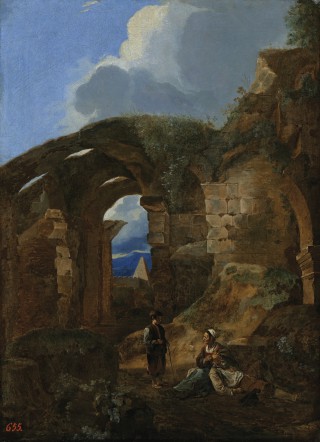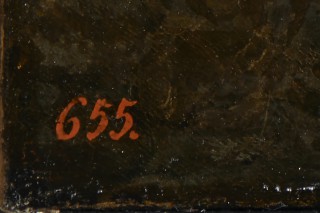Peasants Resting Among Roman Ruins
- Date
- 2nd half of the 17th c.
- Object type
- painting
- Technique
- oil
- Material
- canvas
- Dimensions
- 65,6 x 47,6 cm
- Location
- The Palace on the Isle - Picture Gallery, ground floor
- Marks and inscriptions
- red number 655 (first figure incorrect) of the Stanisław August collection, bottom left
- Place of Origin
- Rome (Italy)
- Owner
- National Museum in Warsaw
- Acquisition name
- deposit; inv. no. M.Ob.488
- Museum number
- Dep 927
… The rendering of the figures of the staffage has some affinities with Cerquozzi’s manner, but the background with the ruins of ancient buildings is not typical of his oeuvre. It brings to mind the works of the Neapolitan, Viviano Codazzi, painted in the 1650s, in Rome—in collaboration with Cerquozzi, who painted the staffage. Influenced by his contact with the Roman landscape, Codazzi—whose art had its origins in quadratura painting—moved away from strictly architectural views emphasizing the principles of geometrical perspective towards more realistic depictions in which ruined buildings were part of a picturesque landscape, rather than a monumental scenographic decoration … .
In the Łazienki painting, the sun-drenched remains of an ancient building, resembling the ruins of the Roman Temple of Minerva Medica, form the setting for a tranquil genre scene showing an old couple resting and a boy. The Pyramid of Cestius is visible in the distance through an open archway, as is a wall with characteristic crenellation reminiscent of the Aurelian walls. The warm tones of the stone buildings, overgrown with sparse, somewhat vaguely treated, vegetation, contrast with the blue sky. The author of the picture can be sought among the followers of Codazzi: he lacks the master’s skill in depicting the structure of the architecture, as well as various textures of brick and stone … . We believe the architecture and staffage in the Łazienki picture are the work of one person (not a specialist of architectural views); however, we are unable to propose a convincing attribution to a particular artist. [D. Juszczak, H. Małachowicz, The Stanisław August Collection of Paintings at the Royal Łazienki. Catalogue, Royal Łazienki Museum, Warsaw 2016, no. 129, p. 473.]



